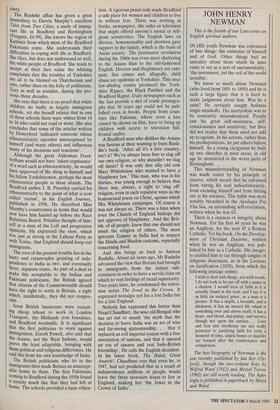JOHN HENRY NEWMAN
This is the fourth of our Lent series on English spiritual authors.
IN HIS youth Newman was convinced of two things: the existence of himself and of God. Other things had an unreality about them which he later came to see as a sort of sacramentality, `the instrument, yet the veil of the world invisible'.
We know so much about Newman (who lived from 1801 to 1890) and he is such a large figure that it is hard to make judgments about him. Was he a saint? He certainly sought holiness single-mindedly. His martyrdom was to be constantly misunderstood. People saw his great self-awareness, self- consciousness and sensitivity, but they did not realise that these need not add up to egoism. In his actions, rather than his predispositions, he put others before himself. As a young clergyman he built up two churches in poor areas; in old age he ministered in the worst parts of Birmingham.
This misunderstanding of Newman was made easier by his principle of reserve, which meant that he refrained from baring his soul indiscriminately, from excusing himself and from hitting out at his enemies. This habit was most notably breached in the Apologia Pro Vita Sua, an astonishing self-revelation, written when he was 63.
There is a oneness or integrity about Newman. For his first 44 years he was an Anglican, for the next 45 a Roman Catholic. Yet his book, On the Develop- ment of Christian Doctrine, written when he was an Anglican, was pub- lished by him as a Catholic. His integri- ty enabled him to cut through tangles of religious dissension, as in his Lectures on Justification (1838), from which the following passage comes: I wish to deal with things, not with words. I do not look to be put off with a name or a shadow. I would treat of faith as it is actually found in the soul; and I say it is as little an isolated grace, as a man is a picture. It has a depth, a breadth, and a thickness; it has an inward life which is something over and above itself; it has a heart, and blood, and pulses, and nerves, though not upon the surface.... Love and fear and obedience are not really posterior to justifying faith for even a moment of time, unless bones or muscles are formed after the countenance and complexion.
The best biography of Newman is the one recently published by Ian Ker (Ox- ford), though the two-volume lives by Wilfrid Ward (1912) and Meriol Trevor (1962) are still worth reading. The Apo- logia is published in paperback by Sheea and Ward.
















































 Previous page
Previous page